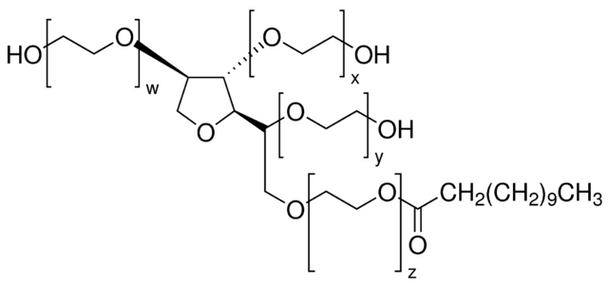Description
TWEEN 20
viscous liquid, suitable for cell culture
Synonym: Polyethylene glycol sorbitan monolaurate, Polyoxyethylenesorbitan monolaurate, Polysorbate 20
-
CAS Number 9005-64-5
-
MDL number MFCD00165986
Properties
| Related Categories | Antigen-Vaccine Preparation, Biochemicals and Reagents, Biological Detergents, Cell Biology, Cell Culture, Cell Lysis Reagents, Cell Signaling and Neuroscience, Core Bioreagents, Detergents, Detergents A to M, Detergents by Applications, Diagnostic Applications, Drug Delivery-Liposomes, Electrophoresis Chromatography, Enzymology, General Reagents, Life Science Reagents for Cell Culture, Membrane Protein Solubilization, Non-Ionic Detergents, Reagents and Supplements, Research Essentials, Signal Transduction Research Tools |
| Quality Level | PREMIUM |
| description | non-ionic |
| assay | ≥40.0% |
| form | viscous liquid |
| mol wt | ~1228 |
| composition | lauric acid, ≥40% (balance primarily myristic, palmoyic, and stearic acids) |
| application(s) | cell culture | mammalian: suitable |
| refractive index | n20/D 1.468 (lit.) |
| CMC | 0.06 mM (20-25°C) |
| transition temp | cloud point 76 °C |
| density | 1.095 g/mL at 25 °C (lit.) |
| m | 1.1 g/cm3 at 25 °C (lit.) |
| HLB | 16.7 |
General description
Tween 20 is a polyoxyethylene sorbitol ester that belongs to the polysorbate family. It is a nonionic detergent having a molecular weight of 1,225 daltons, assuming 20 ethylene oxide units, 1 sorbitol, and 1 lauric acid as the primary fatty acid. The ethylene oxide subunits are responsible for the hydrophilic nature of the surfactant, while the hydrocarbon chains provide the hydrophobic environment. Sorbitol forms the backbone ring to which the ethylene oxide polymers are attached.[1]
Application
TWEEN 20 has been used in staining buffer for in situ hybridization. It has also been used to prevent non-specific adsorption of proteins to coverslip during sample preparation for FRET (Förster resonance energy transfer) experiments.[3]
TWEEN 20 is a nonionic detergent widely used in biochemical applications. It has been used as an emulsifying agent for the preparation of stable oil-in-water emulsions. TWEEN 20 has been used in pre-extraction of membranes to remove peripheral proteins (used at 2% for extraction of membrane-bound proteins).
TWEEN 20 has been used as a blocking agent for membrane based immunoassays at a typical concentration of 0.05%. TWEEN 20 can be used for lysing mammalian cells at a concentration of 0.005 to 0.5%.
Non-ionic detergent
Packaging
100, 500 mL in poly bottle
4 L in poly bottle
Caution
TWEEN 20 may not be stable to autoclaving, particularly with metal cations in buffer solutions. Autoclaving is not recommended without testing for changes in properties. TWEEN 20 is heat sensitive and will darken when exposed to elevated temperatures. Polysorbates have been reported to be incompatible with alkalis, heavy metal salts, phenols, and tannic acid. They may also reduce the activity of many preservatives. Aqueous solutions of polysorbates undergo autoxidation during storage, with changes being catalyzed by light, increased temperature, and copper sulfate.
Preparation Note
TWEEN 20 is miscible in water (100mg/mL), yielding a clear, yellow solution. It is also miscible with alcohol, dioxane, and ethyl acetate. TWEEN 20 is insoluble in liquid paraffin and fixed oils.
Legal Information
TWEEN is a registered trademark of Croda International PLC





